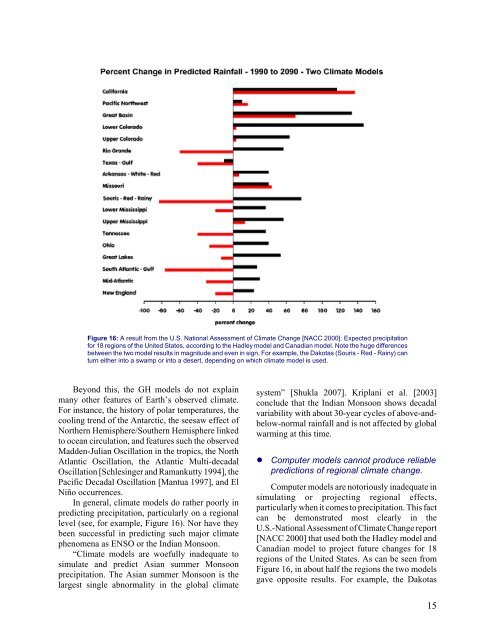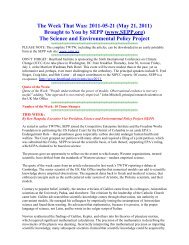Nature, Not Human Activity, Rules the Climate - Science ...
Nature, Not Human Activity, Rules the Climate - Science ...
Nature, Not Human Activity, Rules the Climate - Science ...
You also want an ePaper? Increase the reach of your titles
YUMPU automatically turns print PDFs into web optimized ePapers that Google loves.
Figure 16: A result from <strong>the</strong> U.S. National Assessment of <strong>Climate</strong> Change [NACC 2000]: Expected precipitationfor 18 regions of <strong>the</strong> United States, according to <strong>the</strong> Hadley model and Canadian model. <strong>Not</strong>e <strong>the</strong> huge differencesbetween <strong>the</strong> two model results in magnitude and even in sign. For example, <strong>the</strong> Dakotas (Souris - Red - Rainy) canturn ei<strong>the</strong>r into a swamp or into a desert, depending on which climate model is used.Beyond this, <strong>the</strong> GH models do not explainmany o<strong>the</strong>r features of Earth’s observed climate.For instance, <strong>the</strong> history of polar temperatures, <strong>the</strong>cooling trend of <strong>the</strong> Antarctic, <strong>the</strong> seesaw effect ofNor<strong>the</strong>rn Hemisphere/Sou<strong>the</strong>rn Hemisphere linkedto ocean circulation, and features such <strong>the</strong> observedMadden-Julian Oscillation in <strong>the</strong> tropics, <strong>the</strong> NorthAtlantic Oscillation, <strong>the</strong> Atlantic Multi-decadalOscillation [Schlesinger and Ramankutty 1994], <strong>the</strong>Pacific Decadal Oscillation [Mantua 1997], and ElNiño occurrences.In general, climate models do ra<strong>the</strong>r poorly inpredicting precipitation, particularly on a regionallevel (see, for example, Figure 16). Nor have <strong>the</strong>ybeen successful in predicting such major climatephenomena as ENSO or <strong>the</strong> Indian Monsoon.“<strong>Climate</strong> models are woefully inadequate tosimulate and predict Asian summer Monsoonprecipitation. The Asian summer Monsoon is <strong>the</strong>largest single abnormality in <strong>the</strong> global climatesystem” [Shukla 2007]. Kriplani et al. [2003]conclude that <strong>the</strong> Indian Monsoon shows decadalvariability with about 30-year cycles of above-andbelow-normalrainfall and is not affected by globalwarming at this time.! Computer models cannot produce reliablepredictions of regional climate change.Computer models are notoriously inadequate insimulating or projecting regional effects,particularly when it comes to precipitation. This factcan be demonstrated most clearly in <strong>the</strong>U.S.-National Assessment of <strong>Climate</strong> Change report[NACC 2000] that used both <strong>the</strong> Hadley model andCanadian model to project future changes for 18regions of <strong>the</strong> United States. As can be seen fromFigure 16, in about half <strong>the</strong> regions <strong>the</strong> two modelsgave opposite results. For example, <strong>the</strong> Dakotas15





